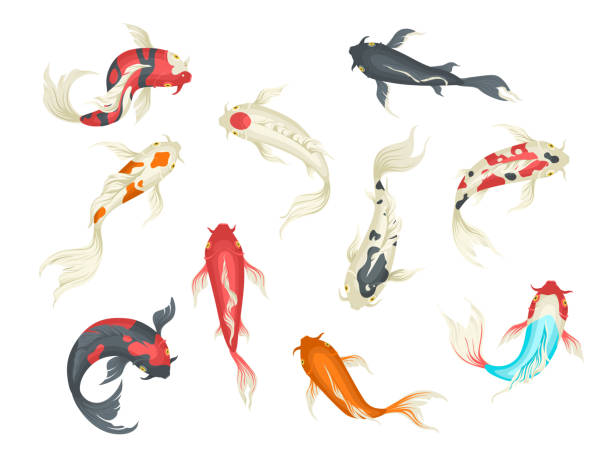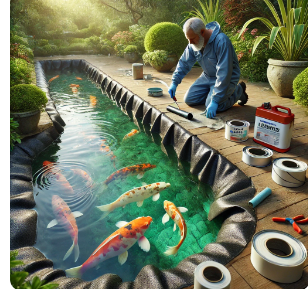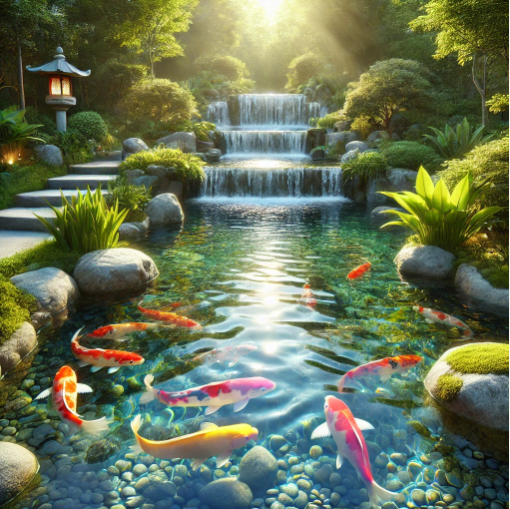Koi fish are admired for their stunning colors and intricate patterns, making them one of the most prized freshwater fish in the world. Their beauty isn’t just random—it’s the result of centuries of selective breeding. Understanding koi fish patterns and colors is essential for both beginners and experienced koi keepers.
In this guide, we’ll break down the different koi color variations, popular patterns, and what they mean in the koi-keeping world.
1. The Basics of Koi Fish Colors
Koi fish come in a wide range of colors, and each hue has its own significance. The most common base colors in koi include:
- White (Shiro) – Represents purity and clarity
- Red (Hi) – Signifies energy, power, and luck
- Black (Sumi) – Adds contrast and represents strength
- Yellow (Ki) – Less common but symbolizes good fortune
- Orange (Orenji) – A warm and inviting color
- Blue (Ai) – Represents calmness and depth
- Metallic (Ginrin/Kin) – Gives koi a shimmering, reflective shine
Each koi variety is a combination of these colors and unique patterns, making them truly one-of-a-kind.
2. Understanding Koi Fish Patterns
Patterns are what distinguish one koi variety from another. Some koi have large, bold markings, while others have delicate, intricate designs.
A. Kohaku Pattern (Red & White)
- Description: A white-bodied koi with bold red (hi) markings
- Ideal Pattern: The red should be even and balanced across the body
- Symbolism: Kohaku koi are considered lucky and peaceful
🔹 Fun Fact: Kohaku is one of the oldest and most famous koi varieties!
B. Taisho Sanke (Red, White & Black)
- Description: A white koi with red (hi) and black (sumi) spots
- Key Difference: Unlike Kohaku, Sanke has black markings
- Ideal Pattern: The black should be small, balanced, and not overpowering
🔹 Pro Tip: The best Sanke koi have clear, distinct colors without blending.
C. Showa Sanshoku (Black, Red & White)
- Description: A black-based koi with red (hi) and white (shiro) markings
- Key Difference: Showa has more black than Sanke
- Symbolism: Showa koi represent balance and harmony
🔹 Fun Fact: Unlike Sanke, Showa koi often have black markings on their heads.
D. Utsurimono (Black-Based Koi)
- Types:
- Shiro Utsuri – Black koi with white patterns
- Hi Utsuri – Black koi with red patterns
- Ki Utsuri – Black koi with yellow patterns (rare!)
🔹 Pro Tip: A high-quality Utsuri should have deep, jet-black coloring and symmetrical patterns.
E. Asagi (Blue & Red Koi)
- Description: Light blue net-like scales with red markings on the belly
- Ideal Pattern: The blue should be clean, without messy patches
- Symbolism: Asagi koi are one of the oldest traditional varieties
🔹 Fun Fact: A perfectly balanced Asagi koi is considered a collector’s dream.
F. Shusui (Scaleless Blue & Red Koi)
- Description: Similar to Asagi but scaleless
- Ideal Pattern: A neat row of dark blue scales along the spine
- Key Difference: Shusui has a smooth, almost transparent skin
🔹 Pro Tip: Shusui koi look best with evenly spaced blue scales.
G. Metallic Koi (Ogon)
- Types:
- Yamabuki Ogon – Solid gold-colored koi
- Platinum Ogon – Bright white metallic koi
- Hi Ogon – Deep orange metallic koi
🔹 Fun Fact: Metallic koi shine brighter in clear water due to their reflective scales.
H. Butterfly Koi (Long-Finned Koi)
- Description: These koi have long, flowing fins
- Symbolism: Butterfly koi are admired for their graceful swimming style
- Best Colors: White, orange, black, and blue
🔹 Pro Tip: Longer fins indicate higher quality Butterfly Koi.
I. Ginrin (Sparkling Scales Koi)
- Description: Koi with diamond-like reflective scales
- Ideal Pattern: The shine should be consistent across the body
- Types: Ginrin Kohaku, Ginrin Sanke, Ginrin Showa
🔹 Pro Tip: The more sparkle and symmetry, the more valuable the koi
J. Tancho (Single Red Spot Koi)
- Description: White koi with a perfect red circle on its head
- Symbolism: Resembles the Japanese flag, making it highly prized
- Best Shape: The red spot should be round, centered, and bold
🔹 Fun Fact: Tancho koi are very rare and highly valued in competitions.
3. Choosing the Right Koi for Your Pond
When selecting a koi fish, consider: ✔ Water quality – Clear water brings out koi colors
✔ Sunlight exposure – Too much sunlight can fade koi patterns
✔ Personal preference – Choose koi colors and patterns that you love
4. What Affects Koi Colors & Patterns?
A koi’s colors and patterns can change over time due to several factors:
✔ Diet: High-quality food enhances koi colors
✔ Water temperature: Cold water can darken colors, while warm water can lighten them
✔ Genetics: Some koi are naturally more vibrant than others
✔ Stress levels: Healthy koi have stronger, brighter colors
🔹 Pro Tip: Feeding koi a diet rich in spirulina and color-enhancing food can help intensify their colors.
Final Thoughts
Koi fish patterns and colors make them unique and fascinating. Whether you prefer the classic red and white Kohaku, the bold black Showa, or the shimmering metallic Ogon, each koi variety has its own charm and significance.
Key Takeaways:
✔ Koi come in a variety of colors, including red, white, black, yellow, and blue
✔ Patterns like Kohaku, Showa, and Sanke are the most popular
✔ Metallic koi (Ogon, Ginrin) have a reflective, shimmering appearance
✔ Koi colors and patterns change over time due to genetics, diet, and water conditions
By understanding koi colors and patterns, you can choose the perfect koi for your pond and enjoy their beauty for years to come! 🐠💦
📌 Which koi variety is your favorite? Let us know in the comments!




